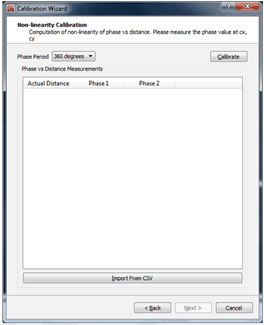SBOU157 September 2015 OPT8241
- Voxel Viewer
4.4 Nonlinearity Calibration
For best accuracy, the relatively small nonlinear relationship that exists between the raw phase measurement and actual depth must be taken into consideration. Such relationship requires taking small steps between the starting position, and the end position, such that the travel spans the full 2π phase interval. Voxel Viewer can take in calibration data in *.csv format collected at calibrated optical center (cx, cy), in the following form:
<Actual Distance>, <Phase1>, <Phase2>
<Actual Distance> is the actual distance, <Phase1> is the phase measured at the first modulation frequency, and <Phase2> is phase measured at the second modulation frequency. These two modulation frequencies work together in the de-aliasing operation.
 Figure 30. Frequency Calibration Window
Figure 30. Frequency Calibration Window